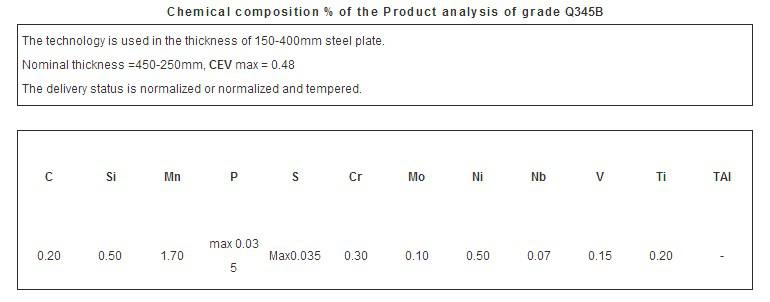
usually construction material is Q345B, and we also use it to make excavator long arm, below is Q345B element table, we will explain in detailed about each element
Carbon – is generally considered to be the most important alloying element in steel and can be present up to 2% (although most welded steels have less than 0.5%). Increased amounts of carbon increase hardness and tensile strength, as well as response to heat treatment (hardenability). Increased amounts of carbon will reduce weldability.
Sulfur – is usually an undesirable impurity in steel rather than an alloying element. In amounts exceeding 0.05% it tends to cause brittleness and reduce weldability. Alloying additions of sulfur in amounts from 0.10% to 0.30% will tend to improve the machinability of a steel. Such types may be referred to as “resulfurized” or “free-machining”. Free-machining alloys are not intended for use where welding is required.
Phosphorus – is generally considered to be an undesirable impurity in steels. It is normally found in amounts up to 0.04% in most carbon steels. In hardened steels, it may tend to cause embrittlement. In low-alloy high-strength steels, phosphorus may be added in amounts up to 0.10% to improve strength and corrosion resistance.
Silicon – Usually only small amounts (0.20%) are present in rolled steel when it is used as a deoxidizer. However, in steel castings, 0.35 to 1.00% is commonly present. Silicon dissolves in iron and tends to strengthen it. Weld metal usually contains approximately 0.50% silicon as a deoxidizer. Some filler metals may contain up to 1% to provide enhanced cleaning and deoxidation for welding on contaminated surfaces. When these filler metals are used for welding on clean surfaces, the resulting weld metal strength will be markedly increased. The resulting decrease in ductility could resent cracking problems.
Manganese – Steels usually contain at least 0.30% manganese because it assists in the deoxidation of the steel, prevents the formation of iron sulfide and inclusions, and promotes greater strength by increasing the hardenability of the steel. Amounts of up to 1.5% can be found in some carbon steels.
Chromium – is a powerful alloying element in steel. It strongly increases the hardenability of steel, and markedly improves the corrosion resistance of alloys in oxidizing media. Its presence in some steels could cause excessive hardness and cracking in and adjacent to welds. Stainless steels may contain in excess of 12% chromium.
Molybdenum – This element is a strong carbide former and is usually present in alloy steels in amounts less than 1%. It increases hardenability and elevated temperature strength. In austenitic stainless steels it improves pitting corrosion resistance.
Nickel – is added to steels to increase hardenability. It often improves the toughness and
ductility of the steel, even with the increased strength and hardness it brings. It is frequently used to improve toughness at low temperature.
Aluminum – is added to steel in very small amounts as a deoxidizer. It also is a grain refiner for improved toughness; steels with moderate aluminum additions have been made to a “fine grain practice”.
Vanadium – The addition of vanadium will result in an increase in the hardenability of a steel. It is very effective, so it is added in minute amounts. At greater than 0.05%, there may be a tendency for the steel to become embrittled during thermal stress relief treatments.
General Steel Definitions: Ingot iron – 0.03% maximum carbon, used for enameling, galvanizing, deep drawing sheet and strip, excellent weldability. Low-carbon – 0.15% maximum carbon, used for electrodes, plate and shapes, sheet, strip, excellent weldability. Mild steel – 0.15-0.30% maximum carbon, used for structural shapes, plates and bars, good weldability. Medium carbon – 0.30-0.50% maximum carbon, used for machinery parts, fair weldability – preheat and postheat may be needed. High carbon – 0.50-1.00% maximum carbon, used for springs, dies, rails, poor weldability – difficult to weld without preheat and postheat.